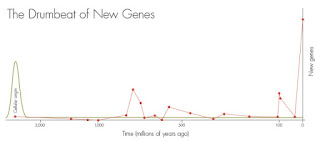 |
| Skip Sterling for Quanta Magazine |
Topics: Biology, Diversity, Diversity in Science, DNA, Women in Science
Note: I'm in a process integration class for work, August 20 and 21st. I will also take some time offline to celebrate my youngest son's 23rd birthday. Taking a "human" break celebrating my own version of new genes; resuming Monday.
Emerging data suggests the seemingly impossible — that mysterious new genes arise from “junk” DNA.
Genes, like people, have families — lineages that stretch back through time, all the way to a founding member. That ancestor multiplied and spread, morphing a bit with each new iteration.
For most of the last 40 years, scientists thought that this was the primary way new genes were born — they simply arose from copies of existing genes. The old version went on doing its job, and the new copy became free to evolve novel functions.
Certain genes, however, seem to defy that origin story. They have no known relatives, and they bear no resemblance to any other gene. They’re the molecular equivalent of a mysterious beast discovered in the depths of a remote rainforest, a biological enigma seemingly unrelated to anything else on earth.
Quanta Magazine: A Surprise Source of Life’s Code, Emily Singer

Comments